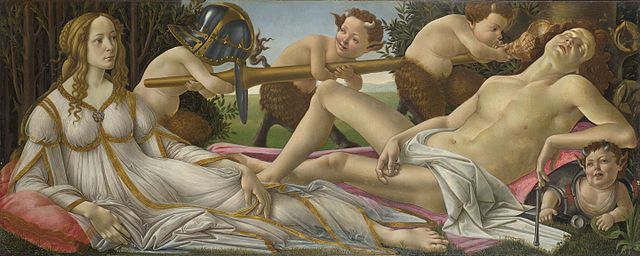
Name: Venus and Mars
Artist: Sandro Botticelli
Date Painted: c. 1485
Period: Renaissance
Dimensions: 69cm (h) x 173cm (w)
Medium / Material: Tempera and Oil on Poplar Panel
Current Location: The National Gallery, London
Introduction
Sandro Botticelli’s “Mars and Venus” is a captivating painting that epitomizes the humanist interest in classical mythology during the Renaissance. This work, believed to have been painted in the late 1480s, is now housed in the National Gallery, London. It presents the Roman gods Venus, the goddess of love, and Mars, the god of war, in a scene brimming with allegorical meaning and aesthetic beauty. Through this piece, Botticelli explores themes of love, war, and peace, employing a delicate balance of mythology and artistic expression.
Composition and Subject
The painting depicts Venus watching over Mars as he sleeps, seemingly exhausted by love rather than battle. Venus is alert and composed, embodying the power of love to pacify war. Mars is depicted in a vulnerable state, armor cast aside, suggesting that even the mightiest can be subdued by love’s embrace. The setting is a forested, idyllic landscape, symbolizing the peace and tranquility that love brings to even the most tumultuous of existences.
Four playful satyrs, figures from Roman mythology known for their association with Dionysus (the god of wine and festivity), are included in the scene. They are shown playing with Mars’s armor and blowing a conch shell in his ear, adding a light-hearted, mischievous element to the painting. The satyrs represent the unruly nature of love and the chaos it can bring, contrasting with the serene and commanding presence of Venus.
Symbolism and Interpretation
“Mars and Venus” is rich in symbolic elements, offering multiple layers of interpretation. The juxtaposition of Mars and Venus suggests the balance between masculine and feminine forces, war and love, violence and harmony. The disarmament of Mars symbolizes the pacifying effect of love on aggression, reflecting Renaissance humanist beliefs in the civilizing power of love and beauty.
The presence of the satyrs introduces the idea of fertility and the natural, untamed aspects of love, contrasting with the divine and orderly love represented by Venus. This duality reflects the Renaissance fascination with the complexities of human nature and the universe.
The background, with its peaceful landscape and distant mountains, further emphasizes the theme of harmony and the transformative power of love over chaos and conflict. The wasps’ nest hanging from one of the trees has been interpreted as a symbol of the stings of love or the dangers that can accompany desire, adding depth to the painting’s exploration of love’s dual nature.
Artistic Style
Botticelli’s “Mars and Venus” showcases his mastery of line and form, characteristic of his elegant style. The figures are rendered with grace and clarity, their poses and expressions imbued with a sense of calm and contemplation. The delicate handling of colors and the attention to detail in the textures of skin, fabric, and landscape elements contribute to the ethereal quality of the painting.
Botticelli’s use of perspective and his ability to integrate figures with the natural landscape reflect his innovative approach to composition. The painting’s overall harmony and balance exemplify the ideals of beauty and proportion celebrated in the Renaissance.
Cultural and Historical Context
The painting reflects the Renaissance revival of interest in classical antiquity, drawing on ancient mythology to explore contemporary themes and humanist ideals. It also speaks to the social and political context of Florence during Botticelli’s time, when the Medici family, patrons of Botticelli, promoted art that embodied their humanist beliefs and political aspirations.
“Mars and Venus” can be seen as both a celebration of love’s power and a commentary on the role of art in cultivating the moral and intellectual virtues prized by Renaissance humanist thought. Through this work, Botticelli contributes to the rich tapestry of Renaissance art, exploring timeless themes through the lens of classical mythology and contemporary Florentine culture.
Conclusion
“Mars and Venus” is a testament to Botticelli’s ability to weave complex allegories and profound themes into his works. The painting not only delights the eye with its aesthetic beauty but also engages the mind with its rich symbolism and exploration of the human condition. It stands as a masterful example of Renaissance art’s capacity to harmonize the classical and the contemporary, the spiritual and the secular, in a celebration of human potential and the transformative power of love.